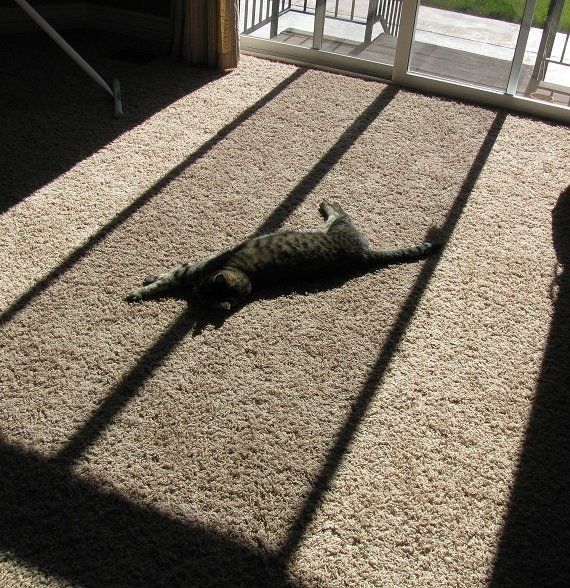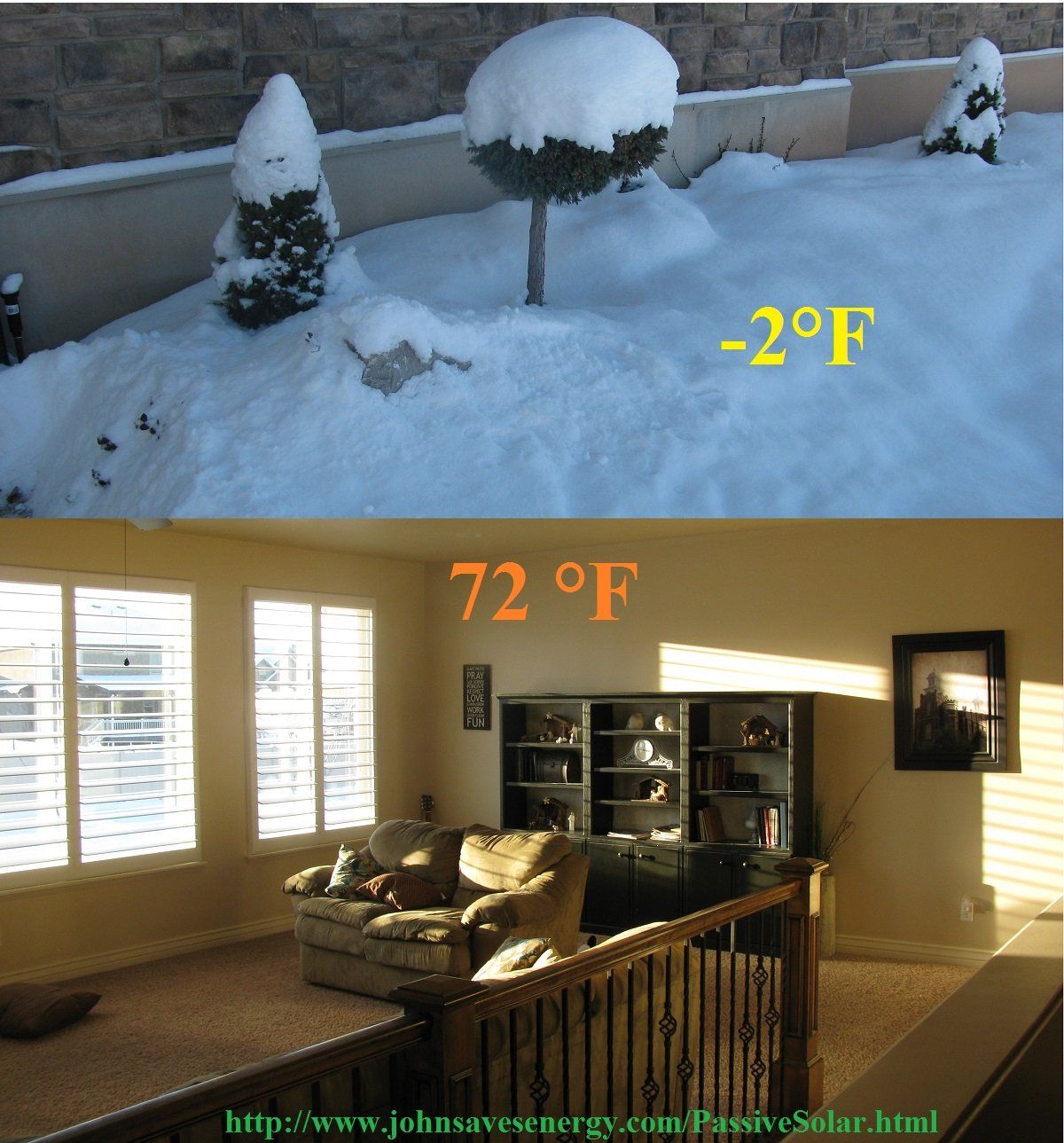Monday, October 7, 2013: Updated Monday February 8, 2016
On cold, sunny, days, open the blinds and curtains on the south side of your home.

Even a house cat knows that sunlight = warm spot. Are you as smart as a cat? Why not use the free energy from the sun to help heat your home this winter?
Allowing passive sunlight to enter the home (even on cloudy days) will make a measurable difference in reducing the energy to heat your home.
Air sealing your home is a must for passive solar heating to be the most effective.
What's wrong with this Davis County neighborhood?

Besides being built right next door to an open air medical waste incinerator and a highway, most of the houses shade their neighbors. In this neighborhood, nobody has access to free, abundant, passive solar heating.
Not only will the residents living in this neighborhood have significantly higher heating bills, statistically they will also have higher incidences of health problems, birth defects and shorter life-spans.
Data showing passive heating at work:
Here are a couple of shots from TED (back when we still had our gas furnace), showing the passive heating of our house on a couple of partly cloudy, winter days. The first it was 23°F outside and the other it was 11°F. The red trace is power draw of the furnace blower. The yellow trace is the sunlight based on solar panel production.

Even though it was 11°F outside, it was a toasty, passively heated 74 degrees inside our house.
Remove the south-facing window screens in the winter time. Doing this will increase the solar heating through these windows by up to 40%. That sounds really high how can that be? Well let's take some measurements.
On a cold but sunny day on October 6th, 2013, Using a light-meter, I recorded the light intensity of the sunlight coming in our sliding door. Floor temperature was also recorded.
Measurement Condition Lux Ratio to full sun Floor Temperature
Window and Screen 28044 0.45 83 °F
Window only 43578 0.70 87 °F
Open Window 62176 1.00 n/a
Hint: On the highest setting (10x) the light meter could only read 19,990 lux. I created an optical attenuator by wrapping a piece of paper around the light sensor. It extended the dynamic range by an extra 3.69 times; enough to directly measure full sunlight.
According to the light meter measurements, the window is letting in 70% of the sunlight. Our south-facing windows have a visible transmittance spec of 0.71, so these measurements are pretty accurate.
In this specific case of our home's window screens, there is a 64.3% reduction in light entering the house. Since only 1/2 of the window has a screen, the total light entering the window is reduced by 32.1%. So yes, removing south-facing window screens in the winter time will admit more light and heat into your home.

For the best passive solar heating, you want a window with a low U-Factor (high R-value) but high solar heat gain coefficient and visible Transmittance.
October 6, 2013: Even though it was only 45°F outside, our house heated up to 76°F. This was a repeat of the previous day where it was even colder the night before but the heat-pump didn't kick on much at all.

Passive solar heating in our home on October 5, 2013
Wash South-facing Windows:
Cleaning the windows (inside and out) will also allow in more solar radiation, heating your home further. As an experiment, I measured 2 windows on our house. One was very dirty and had not been washed in over a year. The other was pretty clean and had I not been conducting this experiment, I would not have washed it otherwise.
Wash Your Optics (Windows) Dirty (lux) Clean (lux) % change
Apparently Clean Window (SE Facing) 43837 44575 1.7%
Dirty Window (East facing) 29630 32140 8.5%
If your windows are very dirty, you are missing out on almost 10% more heat capturing potential. If you windows are apparently clean, it probably isn't worth cleaning them just for the purpose of passive solar heating.
Lux to Watts:
So to convert sunlight to real world watts, as in heating capability, you take the visible transmittance of your window, multiplied by the sine of the sun angle.
At my latitude, on December 21, the sun angle is ~27° degrees. With reference to vertical windows, the sun hits them at an angle of 63° on December 21, and 33° degrees on June 21.
So in the case of our 0.70 windows and an average solar illumination of 1000 watts per square meter, the actual solar heating power entering through the south-facing windows varies from 1000 x 0.70 x 0.891 =
- 623 watts/meter^2 (58.2 watts/ft^2) on Dec 21st,
- 520 watts/meter^2 (48.6 watts/ft^2) in the spring/fall and
- 381 watts/meter^2 (35.7 watts/ft^2) on June 21.
On December 21st, the winter solstice, if it were a perfectly clear, sunny day and all of the shades on the south-facing windows (275 sqft worth) were open, the equivalent of 16,000 watts of heat would enter the home. That's like 10 electric space heaters all running simultaneously, For FREE!!!
In reality, wintertime is a very cloudy, dark time of year. A typical cloudy day reduces the sun's intensity by 5 times. That 16,000 watts is then reduced to 3200 watts or 2 electric space heaters worth of heating energy.
Here's a fun experiment: If one sun is good then 2 suns is better.

11/30/2013 10:30 am. It was 38°F outside at the time this picture was taken.
At night, close up all the window shades to provide extra insulation to the home.

On windows that don't have interior shutters, we installed cordless double-cell shades. They are super easy to open and close. They also have a higher R-value than other window treatments. By closing the blinds and shades at night, the passive solar heat is kept inside the house for longer.
Passive Solar Shading
Keep in mind that terrific passive solar heating needs to be offset in the summer time with terrific summer shading. An ideal home would have eves that would extend out long enough to block all the direct sun-light in the early spring but by late fall begin begin letting in direct sun-light.
Our home was not built with passive heating and cooling in mind so I have compensated buy using shades, shutters and blinds.

Blinds or shutters are nice because in the summer time, you can open them facing up. In this manner they still let in light but not direct sunlight. In the winter time, you can open them facing down letting in the direct sunlight.
Double-cell shades work too. In the summer you leave them down to block out direct sunlight but they are still translucent enough to let in some light. In the winter time you open them up, letting in direct sunlight.
Without passive shading, on June 21, all the south facing windows in my home could potentially let in the equivalent of 7400 watts. That's an extra 2.1 tons of air-conditioning requirements.

